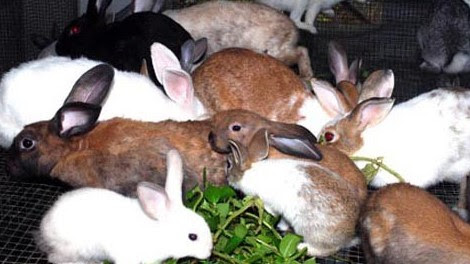The future of rabbit farming in Kenya is great. When done well, rabbit farming has the potential to change livelihoods and employ many youths amid the high Unemployment.
As we reported earlier, Rabbit slaughterhouses in the Country are grappling with an acute shortage of Animals, forcing them to open just thrice a week despite the high demand for the tender Pricey meat in the country.
In this Article, we will look at how Profitable Rabbit Farming is in Kenya and Everything you need to know about this lucrative venture that has not been fully tapped in.

There are several benefits of commercial rabbit farming in Kenya as listed below :
Rabbits are very fast-growing animals like broiler chicken. They gain maturity fast and become suitable for slaughtering purpose within 4-5 months.
Rabbit gestation period is less (generally between 28-31 days) and a doe give birth of kids after every 2 months. Each time one doe can give birth of 8-10 kids.
Starting rabbit farming in Kenya requires very little capital or investment. Even, you can start rabbit farming business in a well ventilated small space.
Food to meat converting rate is higher on rabbit than any other livestock animals.
Rabbit meat is very tasty and nutritious. All types and all aged people can easily consume and digest rabbit meat.
Feeding costs for commercial rabbit farming in Kenya is also very less. You can easily feed your rabbits kitchen wast materials, grasses, plant leaves etc. with their regular commercial feed. This will help you for reducing feeding cost.
Commercial rabbit farming in Kenya can be great source of income and employment. You can successfully use your family labor for rabbit farming business. Rabbit farming is also very pleasuring and entertaining.
AD.

Top Rabbit Breeds in Kenya.
1. New Zealand White
The speed champion of growth.
Reaches an impressive 5-6 kg in just 5-6 months.
Known for producing top-quality, tender meat.
Perfect if you’re focusing on meat production.
2. California White.
The adaptability expert.
Offers excellent meat-to-bone ratio (more meat, less waste!).
Handles different climates like a pro.
Great choice for beginners.
3. Flemish Giant.
The gentle giant of rabbit breeds.
Ideal for both meat and breeding
Perfect if you’re looking to impress with size
Remember: needs more space due to its large size.
4. Chinchilla.
The dual-purpose champion
Valuable for both meat and fur
Unique appearance that catches buyers’ attention
Popular in specialty markets.
5. Kenyan Local Rabbit.
Our homegrown hero!
Naturally resistant to local diseases
Well-adapted to Kenyan climate
Lower maintenance costs.
Before you invest in your first rabbits, let’s dive into the key factors that will help you make the right choice. These considerations will save you time, money, and potential headaches down the road :
1. Purpose of Farming. Ask yourself: “What’s my main goal?”
For meat production: Go for New Zealand White or California White
They offer excellent growth rates
Superior carcass quality
Better return on investment for meat farmers
For breeding stock: Consider breeds with good maternal instincts
For fur production: Look at specialized breeds like Chinchilla
2. Availability in Your Area.
Always buy from trustworthy, reputable breeders
New Zealand White and California White are readily available in Kenya
Easier to find replacement stock
More breeding options.
Usually have established health records
Consider transportation costs if your chosen breeder is far away.
3. Adaptability to Local Climate.
Your rabbits need to thrive in your specific region
The Kenyan Local Rabbit shines here because:
Natural resistance to local diseases
Well-adapted to our climate variations
Lower veterinary costs in the long run
Remember: A breed that works well in Nairobi might struggle in Mombasa!
4. Growth Rate and Productivity.
Look for breeds with proven track records
New Zealand Whites are champions here:
Reach 5-6 kg in just 5-6 months
Excellent feed conversion rates
Consistent growth patterns
Faster growth = quicker returns on your investment.
5. Space Requirements.
Be realistic about your available space
Larger breeds like Flemish Giant:
Need more hutch space
Require stronger housing structures
Eat more food
Smaller breeds:
Perfect for limited space
More efficient in urban farming setups
Lower feed costs.
Rabbit Housing and Management.
Proper housing is crucial for your rabbits’ health and comfort. Here’s what you need to know, whether you’re starting small or going big.
Housing Basics.
Design: Build raised hutches. They protect rabbits from predators and keep their space clean.
Material: Use sturdy wood and wire mesh. Ensure good ventilation and protection from extreme weather.
Size: Each rabbit needs at least 3 square feet. Cramped spaces cause stress and illness.
Types of Rabbit Housing.
Individual Cages: Best for breeding. They prevent fighting and ensure controlled mating.
Colony Housing: Offers more freedom to move, but needs a larger space and regular monitoring.
Practical Tips
Add nest boxes for breeding rabbits to give them a safe, private space for their kits.
Use clean bedding like straw or wood shavings for comfort.
Clean hutches daily to remove waste and prevent diseases.

Cost Estimate.
Small-scale setup (for 10 rabbits): Ksh 15,000–30,000.
Medium-scale setup (for 50 rabbits): Ksh 50,000–100,000.
Feeding and Nutrition For Rabbit Farming in Kenya.
Feeding rabbits properly is essential. It affects their health, growth, and productivity. A balanced diet helps them thrive and keeps costs down.
What to Feed.
1. Hay and Grass (70% of their diet).
They need fiber for digestion and to avoid issues.
Good options are timothy hay, Napier grass, and sweet potato vines.
2. Pellets.
Commercial pellets are vital for their health and growth.
Choose high-fiber, low-calcium pellets to prevent bladder stones.
3. Fresh Vegetables.
Small amounts of carrots, spinach, kale, and cabbage add vitamins.
Too many vegetables can upset their digestion.
4. Clean Water.
Fresh, clean water must be available at all times for their health.
Feeding Guidelines.
Adult Rabbits: Give 120–150 grams of pellets daily, with hay and greens.
Lactating Does: Increase feed for their higher energy needs.
Weaned Kits: Introduce solid food gradually to avoid digestive issues.
Common Diseases in Rabbits.
1. Coccidiosis.
If your rabbits stop eating or have diarrhea, it might be coccidiosis. This intestinal disease spreads rapidly. Here’s how to prevent it:
Keep their area clean and dry—moisture is a big risk.
Consider medicated feed, especially for young rabbits.
Look for early signs: less appetite, dull fur, or watery droppings.
2. Pasteurellosis.
Sneezing or runny noses? Watch out for pasteurellosis. It’s common in Kenya, especially with weather changes. Here’s what to do:
Ensure good airflow in their house, but avoid direct drafts.
Isolate new rabbits for two weeks before introducing them.
Daily checks for sneezing or discharge are essential.
Isolate new rabbits for two weeks before introducing them.
Daily checks for sneezing or discharge are essential.
3. Ear Mites.
Is your rabbit shaking its head or scratching its ears? It might have ear mites. These tiny parasites cause discomfort. Here’s how to stay ahead:
Check their ears weekly—it takes only a minute.
Keep an ear cleaner handy.
Start treatment if you see crusty material in the ears.
Prevention Measures For the Common Diseases.
1. Housing Management.
Your rabbit house is your first line of defense:
Clean the hutches daily—it’s easier than dealing with sick rabbits.
Keep the floor dry—moisture breeds bacteria.
Install proper drainage, especially during the rainy season.
2. Smart Quarantine Practices.
One sick rabbit shouldn’t affect the whole colony:
Set up a separate area for sick rabbits.
Use different feeding equipment for quarantined animals.
Return rabbits to the group only when they’re completely healthy.
3. Essential Vaccinations.
Protect your investment with vaccinations:
Consult your vet about important vaccines for your area.
Keep a vaccination calendar.
Don’t skip boosters—they’re crucial for continued protection.
4. Daily Hygiene Routine.
Simple habits make a big difference:
Clean water containers daily—fresh water is essential.
Disinfect feeding equipment weekly.
Always wash your hands before and after handling rabbits.
Use footbaths at entry points to prevent disease.
5. Working with Your Vet.
Build a good relationship with a local vet who knows rabbits:
Schedule check-ups every 3-4 months.
Keep their number handy for emergencies.
Don’t hesitate to seek help if you notice problems.
When you see these warning signs, act quickly:
Reduced eating or drinking.
Unusual droppings.
Lethargy or behavior changes.
Respiratory issues.
Visible injuries or wounds.
Breeding and Reproduction of Rabbit
Successful breeding is crucial for your rabbit farm’s profitability. It ensures a steady supply of healthy offspring for growth or sale. Managing the breeding process well can greatly boost productivity.
The Breeding Process.
Mating: Always place the doe in the buck’s cage. Bucks perform better in familiar surroundings. Mating is usually quick, so supervise it closely.
Gestation: After mating, the doe will be pregnant for 28 to 31 days. Provide her with a comfortable, stress-free environment during this time.
Litter Size: A doe typically gives birth to 6 to 10 kits per litter. This number can vary based on her age, health, and breed.
Breeding Tips.
Start at the Right Age: Breed does and bucks when they are 5 to 6 months old. This ensures they are physically mature.
Rest Periods: Give does at least two weeks to recover after weaning their kits. Overbreeding can cause stress and reduce productivity.
Provide a Nest Box: A few days before delivery, place a clean nest box with bedding in the doe’s hutch. This keeps the kits warm and safe.
Monitor the Kits: In the first few weeks, ensure the kits are feeding well and staying warm. Minimize handling to avoid disturbing the mother.
Marketing Rabbit Products.
Marketing might seem challenging at first, but I’ve seen many Kenyan rabbit farmers turn their hobby into a thriving business. Let’s explore how you can make the most of every part of your rabbit farming venture.
Products to Market.
1. Premium Rabbit Meat.
High-quality rabbit meat is your main income source. Here’s what works in the Kenyan market:
Package different cuts for different customers – some prefer whole rabbits, others want specific cuts
Highlight the health benefits: low fat, high protein, and perfect for health-conscious customers
Build relationships with local butcheries and restaurants – they often become regular buyers
Consider supplying to high-end supermarkets in urban areas
2. Breeding Stock.
Many new farmers need quality breeding rabbits. Here’s how to tap this market:
Keep detailed records of your breeding lines
Take good photos of your breeding stock
Build a reputation for healthy, productive animals
Offer basic training to new farmers who buy your rabbits
3. Valuable By-Products.
Don’t overlook these additional income streams:
Rabbit fur – connect with local craft makers and textile businesses
Manure – organic farmers will love its rich nutrient content
Urine – some farmers use it as a natural pesticide
Rabbit pelts – there’s a growing market for treated rabbit skins.
Potential Market.
1. Local Markets.
Start close to home:
Build relationships with local butcheries
Connect with nearby restaurants and hotels
Sell directly to families in your community
Supply to local farmers’ markets
2. Urban Markets.
Cities offer bigger opportunities:
High-end restaurants seeking unique menu items
Health food stores and organic markets
Specialty meat shops
Weekend farmers’ markets in upscale areas.
3. Export Potential.
Think bigger when you’re ready:
Research international quality standards
Connect with export agencies
Join farmer groups targeting export markets
Attend agricultural trade shows.
Practical Marketing Tips.
Setting Prices.
Research current market rates in your area
Consider your production costs
Offer bulk discounts for regular customers
Be flexible during high and low seasons.
Customer Service.
Respond promptly to inquiries
Deliver on time, every time
Keep your promises about quality and quantity
Follow up with customers for feedback
Growing Your Business
Start small but plan for growth
Reinvest some profits in marketing
Keep learning about new market opportunities
Stay updated on industry trends.
Financial Planning and Profitability
Rabbit Farming in Kenya
Effective financial management is crucial for a successful rabbit farming business. Knowing your costs and revenue potential aids in making smart decisions and boosting profits.
Estimated Costs:
Breeding Stock: Starting with 10 healthy rabbits will cost Ksh 5,000–10,000.
Housing: A basic setup for your rabbits costs Ksh 15,000–30,000.
Feeding: Monthly feed costs for 10 rabbits range from Ksh 1,500–3,000, depending on feed type and forage.
Revenue Potential:
A mature rabbit (3–4 months old) sells for Ksh 1,000 to Ksh 3,000, based on the market.
With 50 rabbits, you could earn up to Ksh 150,000 per cycle if you maintain their health and growth.
Profitability Tips:
Reduce feed costs by growing local forage like Napier grass and sweet potato vines.
Manage health to avoid high vet bills, keeping your rabbits productive.
Increase income by selling manure as organic fertilizer and breeding stock to other farmers.
Conclusion.
Rabbit farming in Kenya offers a profitable opportunity for those who manage it well. It requires minimal space and has low startup costs. With a high demand for rabbit meat and fur, this business can ensure a steady income.
To succeed, choose the right rabbit breeds. Ensure they have proper housing and nutrition. Managing diseases effectively is also essential. By focusing on these areas, you can build a thriving rabbit farm. Additionally, look into markets for rabbit manure and fur to boost your profits.
Starting small allows you to learn the necessary skills. As you gain experience, you can expand your farm. With dedication, rabbit farming can offer rewarding returns.
